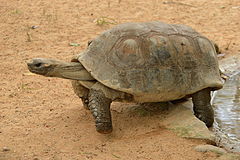Chelonoidis
| Chelonoidis[1] | |||
| Fitzinger, 1835[2] | |||
 Przedstawiciel rodzaju – żabuti leśny (Ch. denticulatus) | |||
| Systematyka | |||
| Domena | |||
|---|---|---|---|
| Królestwo | |||
| Typ | |||
| Podtyp | |||
| Gromada | |||
| Rząd | |||
| Podrząd | |||
| Nadrodzina | |||
| Rodzina | |||
| Rodzaj |
Chelonoidis | ||
| Typ nomenklatoryczny | |||
|
Testudo boiei Wagler, 1833 (= Testudo carbonaria Spix, 1824) | |||
| Synonimy | |||
|
| |||
| Gatunki | |||
| |||
Chelonoidis – rodzaj żółwi z rodziny żółwi lądowych (Testudinidae).
Zasięg występowania
Rodzaj obejmuje gatunki występujące w Ameryce Centralnej (Panama), Południowej (Kolumbia, Wenezuela, Gujana, Surinam, Gujana Francuska, Brazylia, Ekwador, Boliwia, Paragwaj i Argentyna) oraz na wyspach Morza Karaibskiego (Saint Kitts i Nevis (Saint Kitts), Saint Lucia, Saint Vincent i Grenadyny (Saint Vincent) oraz Trynidad i Tobago (Trynidad))[8][9].
Systematyka
Etymologia
- Chelonoidis: gr. χελωνη khelōnē „żółw”[10]; ειδος eidos „kształt, wygląd”, od ειδω eidō „być podobnym, przypominać”[11].
- Gopher: ang. gopher „zwierzę ryjące”, być może od fr. gaufre „plaster miodu”[12]. Gatunek typowy: Testudo (Gopher) chilensis J.E. Gray, 1870.
- Elephantopus: gr. ελεφας elephas, ελεφαντος elephantos „słoń”[13]; πους pous, ποδος podos „stopa”[14]. Gatunek typowy: Testudo planiceps J.E. Gray, 1854[a] (= Testudo nigra Quoy & Gaimard, 1824).
- Pampatestudo: hiszp. pampa „równina”, od keczua pampas „równiny”[15]; łac. testudo, testudinis „żółw”[16]. Gatunek typowy: Testudo (Gopher) chilensis J.E. Gray, 1870.
- Monachelys: gr. μονας monas, μοναδος monados „samotny”, od μοναχοω monakhoō „być samotnym”[17]; χελυς khelus „żółw”[10]. Gatunek typowy: †Testudo (Monachelys) monensis E.E. Williams, 1952.
- Darwintestudo: Charles Robert Darwin (1809–1882), angielski przyrodnik; łac. testudo, testudinis „żółw”[7]. Gatunek typowy: Testudo hoodensis Van Denburgh, 1907.
Podział systematyczny
Do rodzaju należą następujące gatunki[8]:
- Chelonoidis carbonarius (Spix, 1824) – żabuti czarny[18]
- Chelonoidis chilensis (J.E. Gray, 1870)
- Chelonoidis denticulatus (Linnaeus, 1766) – żabuti leśny[19]
- Chelonoidis niger (Quoy & Gaimard, 1824) – żółw słoniowy[19]
Uwagi
Przypisy
- ↑ Chelonoidis, [w:] Integrated Taxonomic Information System (ang.).
- ↑ L.J.F.J. Fitzinger. Entwurf einer systematischen anordnung der schildkröten nach den grundsätzen der natürlichen methode. „Annalen des Wiener Museums der Naturgeschichte”. 1 (1), s. 108, 112, 122, 1836. (niem.).
- ↑ J.E. Gray: Supplement to the catalogue of shield reptiles in the collection of the British Museum. Cz. 1: Testudinata (Tortoises). With Figures of the Skulls of 36 Genera. London: The Trustees, 1870, s. 5. (ang.).
- ↑ J.E. Gray. On the Skulls and Alveolar Surfaces of Land-Tortoises (Testudinata). „Proceedings of the Zoological Society of London”. 1873, s. 724, 1873. (ang.).
- ↑ W.A. Lindholm. Revidiertes Veneichnis der Gattungen der rezenten Schildkroten nebst Notizen zur Nomenklatur einiger Arten. „Zoologischer Anzeiger”. 81, s. 285, 1929. (niem.).
- ↑ E. Williams. A new fossil tortoise from Mona Island, West Indies, and a tentative arrangement of the tortoises of the world. „Bulletin of the American Museum of Natural History”. 99, s. 547, 1952. (ang.).
- ↑ a b S. Antenbrink-Vetter & H. Vetter. Neuer Name für altbekannte Schildkröten. „Schildkröten”. II/98, s. 4, 1998. (niem.).
- ↑ a b P. Uetz & J. Hallermann: Genus: Chelonoidis. The Reptile Database. [dostęp 2024-02-18]. (ang.).
- ↑ R. Midtgaard: Chelonoidis. RepFocus. [dostęp 2024-02-18]. (ang.).
- ↑ a b Jaeger 1944 ↓, s. 47.
- ↑ Jaeger 1944 ↓, s. 79.
- ↑ M.J. Connor & M.A. Cohen: What’s in a Name?. California Turtle & Tortoise Club. [dostęp 2019-12-02]. (ang.).
- ↑ Jaeger 1944 ↓, s. 80.
- ↑ Jaeger 1944 ↓, s. 180.
- ↑ Jaeger 1944 ↓, s. 160.
- ↑ Jaeger 1944 ↓, s. 232.
- ↑ Jaeger 1944 ↓, s. 139.
- ↑ Praca zbiorowa: Zwierzęta: encyklopedia ilustrowana. Warszawa: Wydawnictwo Naukowe PWN, 2005, s. 354. ISBN 83-01-14344-4.
- ↑ a b W. Juszczyk: Gady i płazy. Wyd. 2. Warszawa: Wiedza Powszechna, 1986, s. 279, 300, seria: Mały słownik zoologiczny. ISBN 83-214-0043-4.
Bibliografia
- Edmund C. Jaeger, Source-book of biological names and terms, wyd. 1, Springfield: Charles C. Thomas, 1944, s. 1–256, OCLC 637083062 (ang.).
